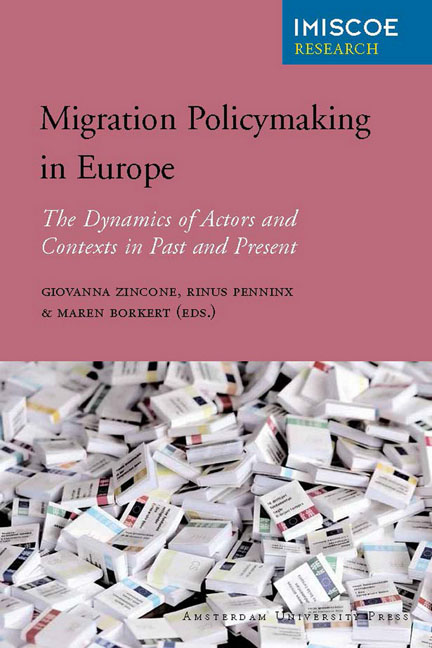Book contents
- Frontmatter
- Contents
- Policymaking in the Field of Migration and Integration in Europe: An Introduction
- Part I Post-War Migration Countries
- Part II Mediterranean Migration Countries
- Part III Eastern European Countries
- Conclusion: Comparing the Making of Migration Policies
- List of Contributors
- Other IMISCOE Titles
1 - The Case of Austria
Published online by Cambridge University Press: 20 January 2021
- Frontmatter
- Contents
- Policymaking in the Field of Migration and Integration in Europe: An Introduction
- Part I Post-War Migration Countries
- Part II Mediterranean Migration Countries
- Part III Eastern European Countries
- Conclusion: Comparing the Making of Migration Policies
- List of Contributors
- Other IMISCOE Titles
Summary
Introduction
In the past two decades, Austrian migration policy as well as its making have undergone radical changes. Though once a subject dealt with mostly by small groups of experts within the administration, trade unions, labour market authorities and employers’ associations, migration has moved to the centre of political debate and to the centre of government. At the same time, there have been several shifts in the institutional framework dealing with migration beginning in the late 1980s. Initial monopolisation of all migration-related issues by the Ministry of Interior has given way to a subsequent emergence of new actors and institutions in the course of the 1990s and into the new millennium.
These changes are linked to broader changes in Austria's political system as well as to changing patterns of migration and its diversification both in terms of types of migration and migrants’ countries of origin. The changing geopolitical context after 1989 – the collapse of Communist regimes in Eastern Europe and the rise of migration flows from them – as well as the Yugoslav crises and their related refugee influxes have functioned as important triggering events for reforming migration policies in the 1990s. The increasing Europeanisation of migration policymaking in the past fifteen years and the EU's enlargements are additional factors shaping both the contents of migration policies as well as the way they are made in Austria.
As background to a more detailed analysis of policymaking, I will first sketch out the main features of immigration into Austria and characteristics of the immigrant populations. In the second part of this introduction, I outline the history of migration policy before the 1990s.
Evolution of immigration and the immigrant population
Post-war migration policies in Austria have been largely shaped by guest worker recruitment. However, what was intended as a temporary, circular form of labour migration soon developed more permanent features based on self-reproducing mechanisms (family migration, chain migration and migrant networks). Already during the initial recruitment period, a considerable share of migrants moved with or joined family members, although they were usually admitted as workers rather than relatives. The recruitment stop in 1974 further increased family migration, in particular children of migrant workers (Kraler 2010: 70ff).
- Type
- Chapter
- Information
- Migration Policymaking in EuropeThe Dynamics of Actors and Contexts in Past and Present, pp. 21 - 60Publisher: Amsterdam University PressPrint publication year: 2012
- 2
- Cited by



